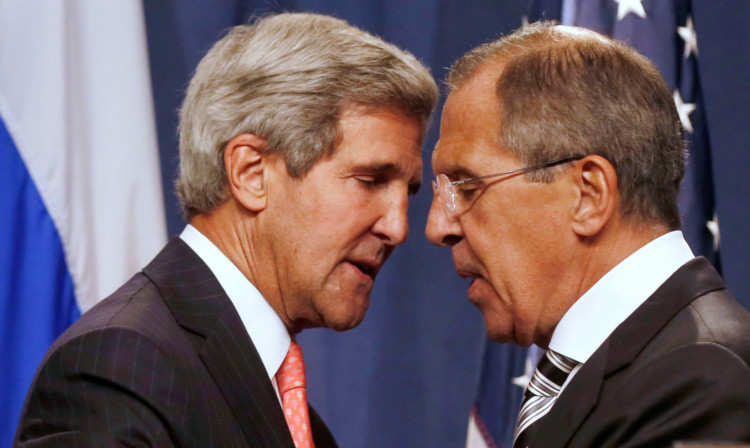
Syria will be forced to give up its chemical weapons next year under the terms of a joint American-Russian deal.
US Secretary of State John Kerry and Russia’s Foreign Minister Sergei Lavrov hammered out an agreement today after three days of talks in Switzerland.
The move has been hailed as a “significant step forward” by British Foreign Secretary William Hague.
The deal requires Bashar al-Assad’s regime to draw up a list of its stockpiled chemical weapons within a week.
Kerry said weapons inspectors will be on the ground in Syria no later than November.
Destruction of the weapons must then be completed halfway through 2014.
Failure to comply could lead to a United Nations Security Council resolution to “secure and destroy” Syria’s chemical weapons and remove its capability to produce more.
That would leave the door open for US military action or sanctions.
Hague who is due to travel to Paris on Monday for a briefing with Kerry and French Foreign Minister Laurent Fabius, has described the deal as “a significant step forward.”
He added: “The priority must now be full and prompt implementation of the agreement, to ensure the transfer of Syria’s chemical weapons to international control.
“The onus is now on the Assad regime to comply with this agreement in full.
“The international community, including Russia, must hold the regime to account.
“This includes doing everything we can to stop the continuing bloodshed in Syria, bringing all sides together to agree a political solution to the conflict.”
Shadow Foreign Minister, Danny Alexander, took to the social media site Twitter to support the deal.
He told followers: “Today’s US/Russ agreement is a significant step forward on the road to identify, secure, and destroy Syria’s stockpile of chemical weapons.”
The diplomatic move has also been backed by the French the only nation willing to join the US in taking military action in Syria.
Mr Fabius said the framework agreement was an “important advance”.
And, in a statement released yesterday, UN Secretary-General Ban Ki-moon pledged “the support of the United Nations in its implementation”.
The US says the Syrian regime killed hundreds in a gas attack last month.
However, the Syrian government denies the allegations and blames rebels for the attack, which the US estimates killed more than 1,400 people. It was still unclear last night whether President Assad would agree to the deal, despite his country’s close relationship with Russia.
Syria is understood to have about 1,000 tonnes (984 tons) of chemical weapons at about 45 sites, according to figures released by US officials.
But the president of Syrian opposition’s supreme military council insists Assad’s forces have been moving their chemical weapons to Lebanon and Iraq.
He said that the deal between the US and Russia on chemical weapons will not resolve the Syrian crisis.
More than 100,000 Syrians have died since the rebel uprising began in 2011. Millions have fled their country and millions more have been left homeless by the bloody civil war.
The opposition Syrian National Council head Salim Idriss said: “We think Russians and Syrian government are wasting time no one’s talking about the massacres in Syria.”
He claimed the Syrian army used poison gas in Damascus on Friday and is preparing to use Scud missiles against rebel areas.

Enjoy the convenience of having The Sunday Post delivered as a digital ePaper straight to your smartphone, tablet or computer.
Subscribe for only £5.49 a month and enjoy all the benefits of the printed paper as a digital replica.
Subscribe